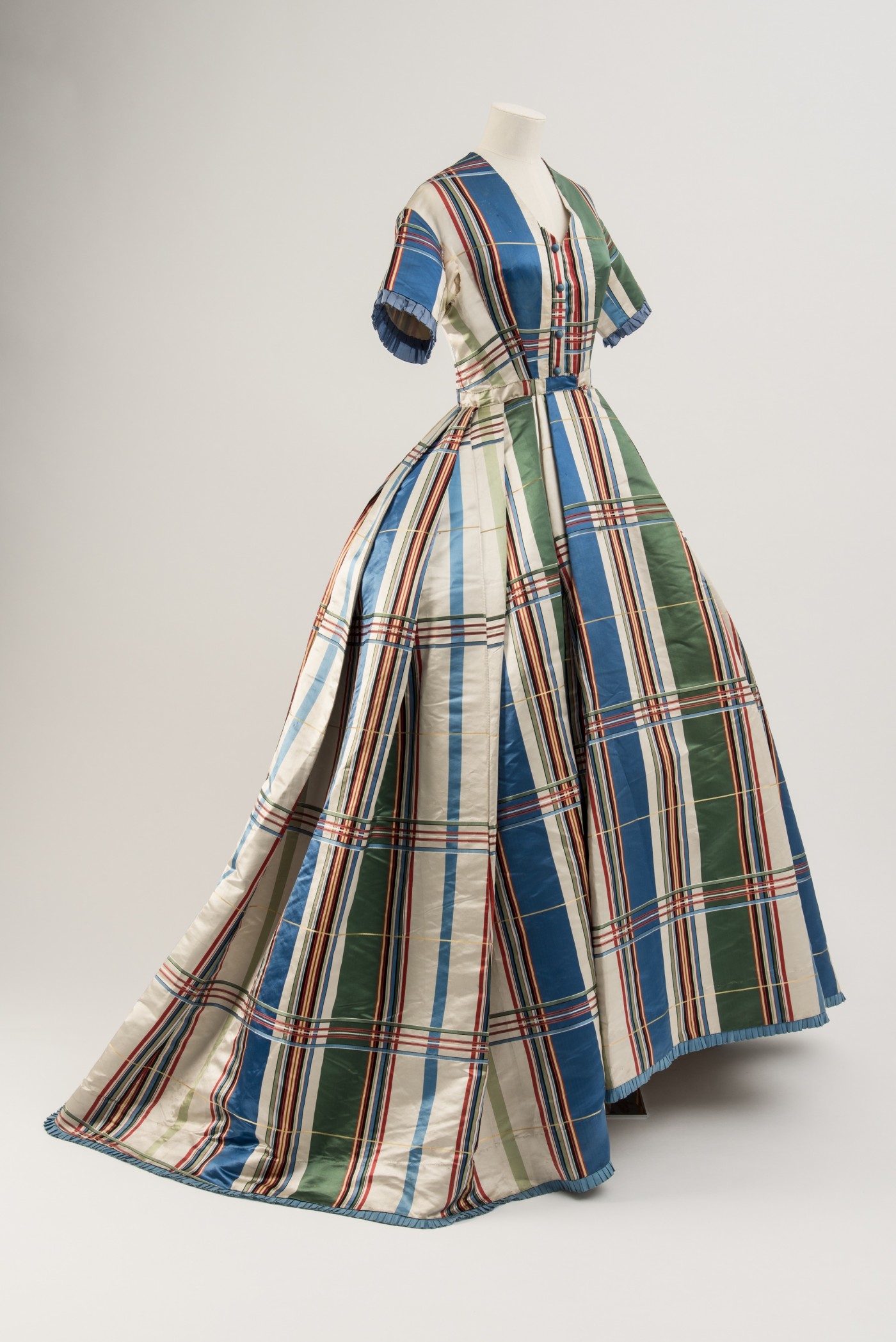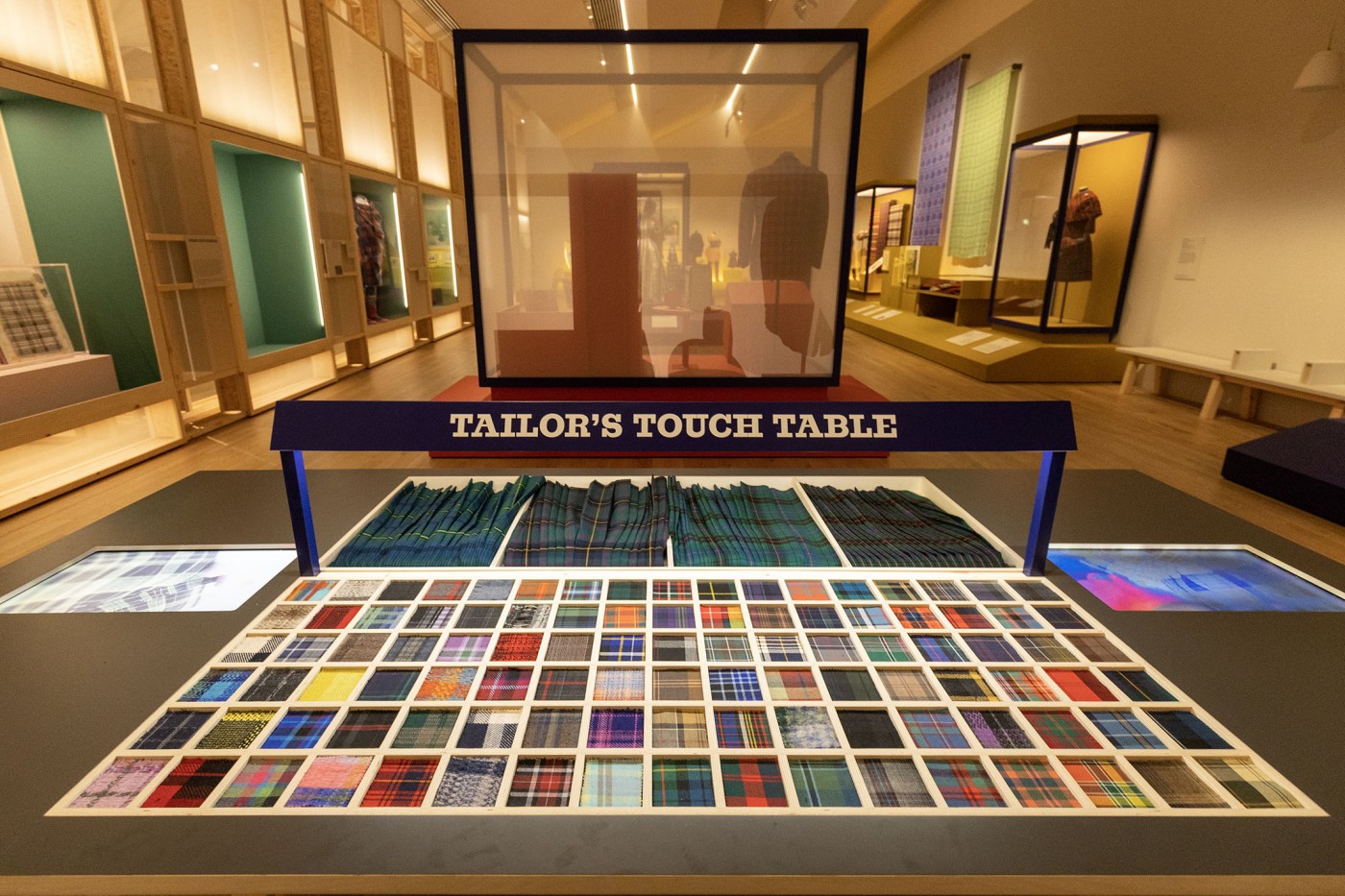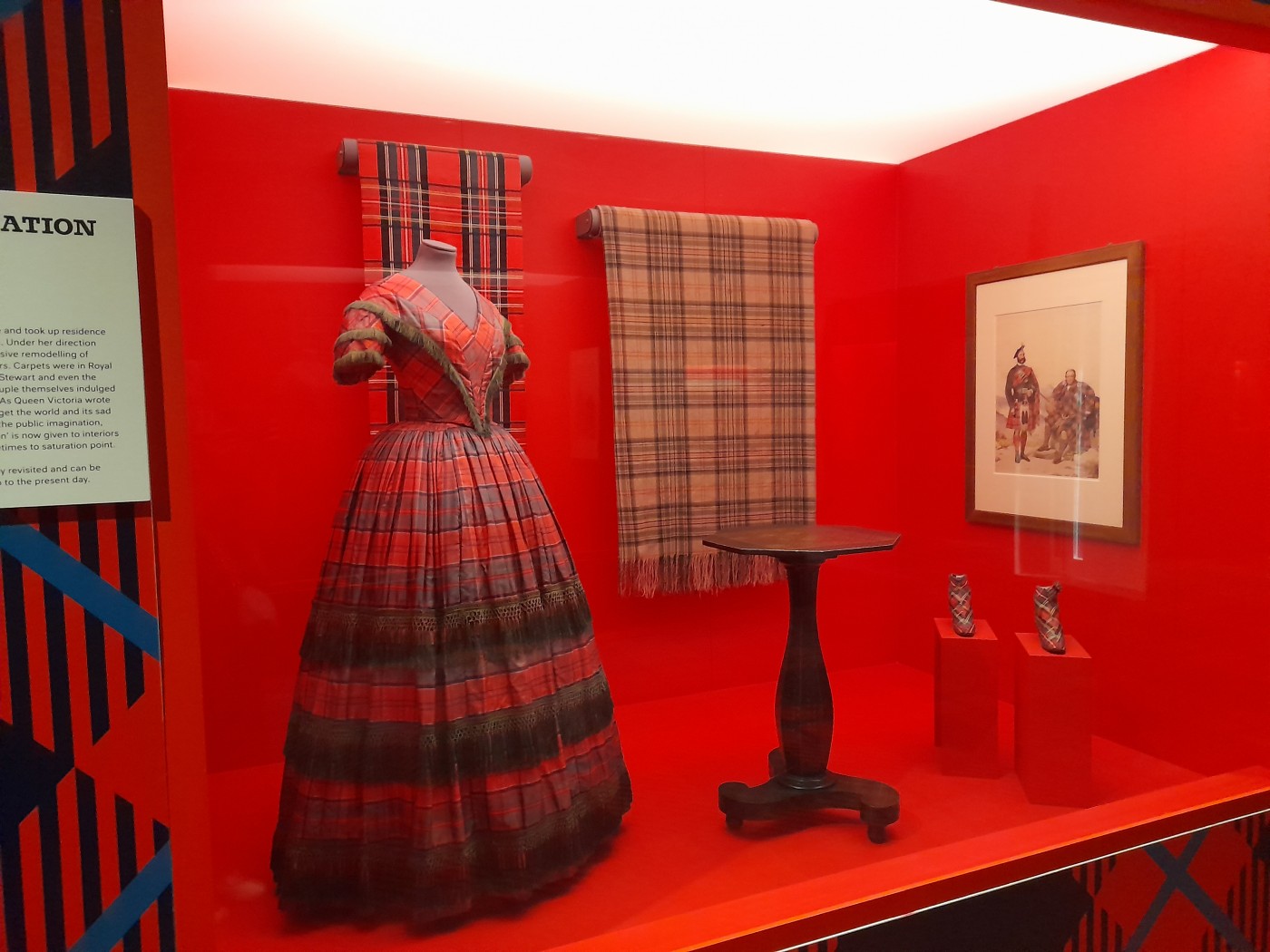- youtube
- bluesky
- Home
- About
- Costume Journal
- Membership
- Conference & Events
- Grants & Awards
- News & Social
In this week's blog, dress historian and past Costume Society Ambassador Victoria Haddock reviews V&A Dundee's Tartan exhibition, on display until January 2024. Celebrating V&A Dundee's 5th anniversary this year, Victoria talks us through the exploration of the iconic textile within the exhibition.
Tartan is the first major exhibition in Scotland in 30 years to focus solely on the iconic textile and ubiquitous pattern that has become an instantly recognisable symbol of Scotland. Curated to celebrate the V&A Dundee’s 5th anniversary in 2023, the exhibition illustrates tartan’s universal and enduring appeal through more than 300 examples of fashion, architecture, graphic and product design, photography, furniture, glass and ceramics, film, performance and art.
The exhibition, inspired by Jonathan Faiers’ book Tartan, is divided into five sections that take the visitor on a linear journey through the story of the iconic patterned textile. Historical and contemporary objects are juxtaposed throughout, illustrating the traditional and radical iterations of tartan.
As a visitor, the first room you enter explores the theme of Tartan and the Grid by introducing the structure of tartan as intersecting grids and colours, and highlights how the principles of colour, pattern, and proportion have influenced art, fashion, and architecture. The section begins by explaining the rules of the grid for weaving tartan and how a true tartan must be made from a minimum of two colours. Line studies of Tartan by Dom Hans van der Laan and flat textiles are juxtaposed with Louise Gray’s colour and pattern clashing 2011 ensemble from her iconic ‘Up Your Look’ collection that took inspiration from tartan’s grids and London’s punk scene. One of the star items on display, for the first time ever, is the oldest-known surviving piece of tartan that was found in a peat bog in Glen Affric, Scotland. Research has dated the woollen specimen to between circa 1500-1600 and it is amazing to see how patterns have evolved to create limitless variations of tartan as you carry on through the exhibition.
London-based design studio Plaid have created a spatial exhibition divided into nine parts, inspired by the weaving process and tartan grid patterns. The structure is made up of showcases and display surfaces, and it is a nice design feature that visitors can see through to other exhibition spaces. The colour palette used was inspired by natural tartan dye samples and colours of the Scottish landscape and doesn’t detract from the objects on display.
The next room focuses on Tartan and Innovation and charts how industry, science, and technology, have constantly reinvented tartan and helped to form its importance in the global marketplace. This large room displays a number of different materials from different eras to illustrate how tartan has evolved with technology, helping to make it a ubiquitous commodity that was adapted to sell the idea of ‘Scotland’ globally. The diplomatic and cultural ties between Scotland and France are examined through the countries’ connected textile heritage that still sees French fashion houses such as Dior and Chanel (who own Scottish heritage knitwear manufacturer Barrie) championing tartan in their collections. Gabrielle ‘Coco’ Chanel was famously influenced by Scotland through her relationship with the wealthy Duke of Westminster, and a 1922 Chanel Ottoman silk cape made in Gordon tartan is featured. A number of audio-visual installations in this section bring tartan’s cultural importance to life, including the first filmed advertisement and James Clerk Maxwell’s developed negatives of a tartan ribbon (displayed through red, green and blue filters) that led to the birth of colour photography.
Throughout the exhibition are a diverse selection of objects and memories that were contributed after a public call-out by the V&A Dundee. The People’s Tartan features items and personal stories from members of the public about what tartan means to them and it was lovely to see the wider community involved with the exhibition and some fascinating objects, including some fabulous handmade clothing made by a fan of the Bay City Rollers in the 1970s and a checked laundry bag purchased at the Park Slope Food co-op in Brooklyn.
The following room, Tartan and Identity, looks at how tartan has become a symbol of expression that has been adopted across the world, often by those wishing to assert their Scottish identity. The 1748 Act of Parliament, prohibiting the wearing of items of Highland dress, is displayed alongside other objects dating from the Jacobite period when tartan was used to show the wearer’s political stance. A number of 1950s tartan outfits owned and worn by the American socialite Frances Farquharson are prominently displayed. Farquharson was a fashion editor for Vogue and Harper’s Bazaar, before marrying the 14th Laird of Invercauld in 1949. She had traditional tartan garments reinterpreted by top designers of the time to help her adapt to her new life as chatelaine at Braemar Castle. A “Tailor’s Touch Table” situated in Tartan and Identity showcases tartan fabric samples and examples of different kilt folds that you can touch.
Tartan use as a political, royal and military force is investigated in Tartan and Power. Some form of tartan has been worn in nearly every British imperial campaign since the 1740s, with the first tartan uniforms having been designed in 1713. A film extract from the National Theatre of Scotland’s 2006 production of Gregory Burke’s Black Watch shows the ‘Fashion’ sequence from the play. The piece is staged as a catwalk where a young soldier gives a historical commentary on conflicts that Scotland has been involved with as he is dressed in Black Watch uniforms dating from 1739 up until 2004. George Napier’s BAFTA-nominated film, 1745, is a powerful watch to accompany a display of objects relating to recent research that has uncovered how tartan was ordered for enslaved people. Members of the royal family have long recognized tartan’s diplomatic and sartorial potential and there is a Dior blouse and kilt ensemble, designed by Marc Bohan, on display that was worn by Wallis Simpson, Duchess of Windsor. In contrast, tartan is also shown as a power of resistance and rebellion through Vivienne Westwood’s punk designs.
The final rooms of the exhibition explore how tartan has amassed an almost mythical status through the theme of Transcendental Tartan. Numerous designers have found inspiration from the textile’s timeless appeal and the visitor can peer into room like structures that highlight tartan throughout the decades. A Victorian room inspired by Queen Victoria’s love of Scotland features a pair of delicate 1850s women’s wool and leather boots with a tartan pattern. Another room focuses on tartan as a force for good and includes a portrait by Gerard M. Burns of Scottish rugby legend and charity campaigner Doddie Weir, who is shown wearing one of his famous suits in the Doddie’5 tartan.
Tartan demonstrates the global reach of the textile through a thought-provoking and detailed exhibition. There is lots to see, read and listen to so do allow plenty of time. Visitors can also pop into the V&A Dundee residency studio to view the work of local weaving studio Coorie Creative, who use a fusion of Japanese and Scottish techniques to create new tartan designs.
Tartan was curated by Kirsty Hassard, Mhairi Maxwell, and Jame Wyle from V&A Dundee with Jonathan Faiers of the University of Southampton and is sponsored by Arnold Clark and supported by LNER and the V&A Foundation.
The exhibition is accompanied by a range of merchandise that has been made in collaboration with designers in Scotland, including a new exclusive tartan designed by Kinloch Anderson. A revised and updated version of Jonathan Faiers’ book, Tartan, has been produced as the official companion to the exhibition.
Tartan is on at the V&A Dundee until 14th January 2024, and is open daily 10:00 – 17:00. Exhibition tickets cost between £7 - £16, with concessions available for students, Young Scot Card Holders, people with disabilities, those in receipt of supported income or unemployment benefits, and Art Fund card holders. V&A members and 18’s and under go free.
Victoria Haddock was previously a Costume Society Ambassador, and a recipient of the Yarwood Grant in 2018. You can read her report on winning the award here.
Image gallery

Satin day dress, c.1865. © Courtesy of Fashion Museum Bath

Tailor’s touch table, V&A Dundee. © Michael McGurk

Tartan exhibition. © Victoria Haddock

Victorian tartan. © Victoria Haddock